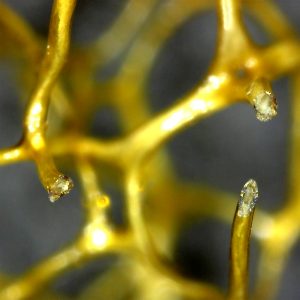Rheology of Marine Sponges Reveals Anisotropic Mechanics & Diverse Dynamics
Emile A. Kraus, Paul A. Janmey, Alison M. Sweeney
Sponges are animals that inhabit many aquatic environments while filtering nutrients and ejecting metabolic wastes. They are composed of cells in a fibrous extracellular matrix that often has an embedded scaffolding of stiff spicules. Sponge tissue exhibits exotic rheological properties such as anisotropic elasticity, auxeticity, shear softening and compression stiffening, negative normal stress, and non-monotonic dissipation as a function of both shear strain and frequency, which suggests tuneage to a specific flow. Growing erect requires aligned, spicule-reinforced fibers that confer 2.5x greater stiffness axially compared to the mutually orthogonal stiffnesses. Shorter, stouter sponges had at least one plane of mechanical symmetry and their tissue was more heterogeneous and dynamic compared to erect forms, suggesting greater flow sensitivity in these sponges.
Beautiful Science page

